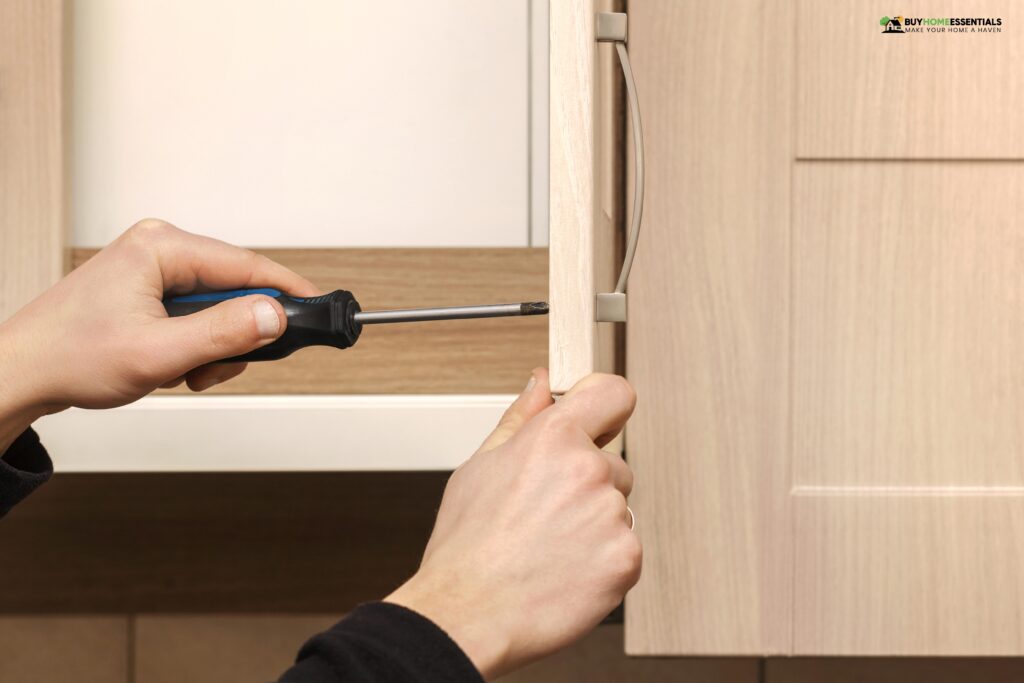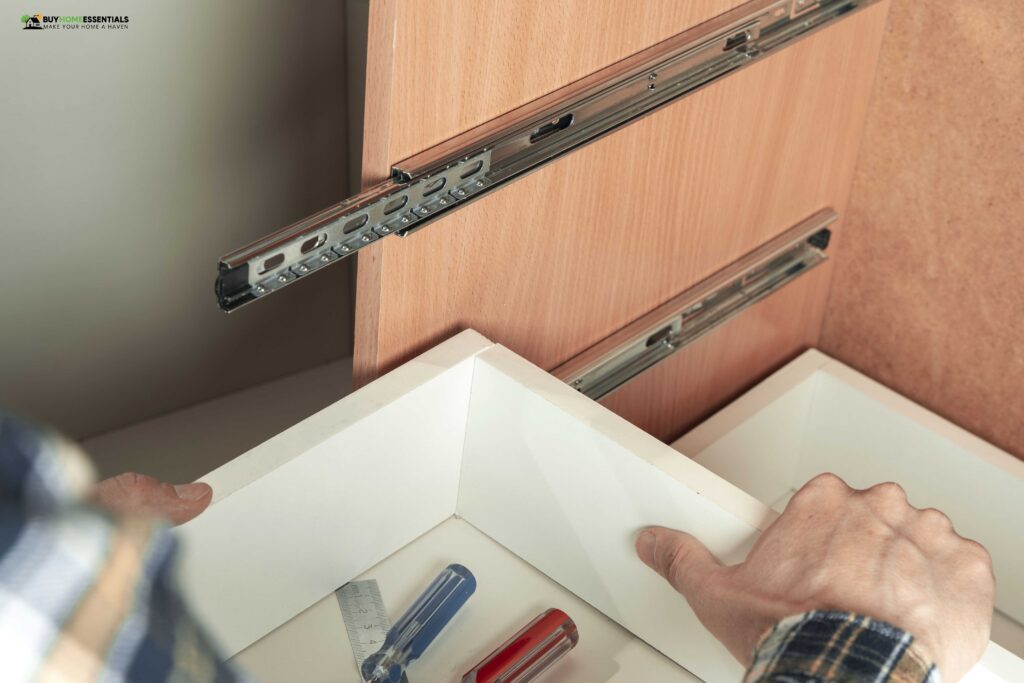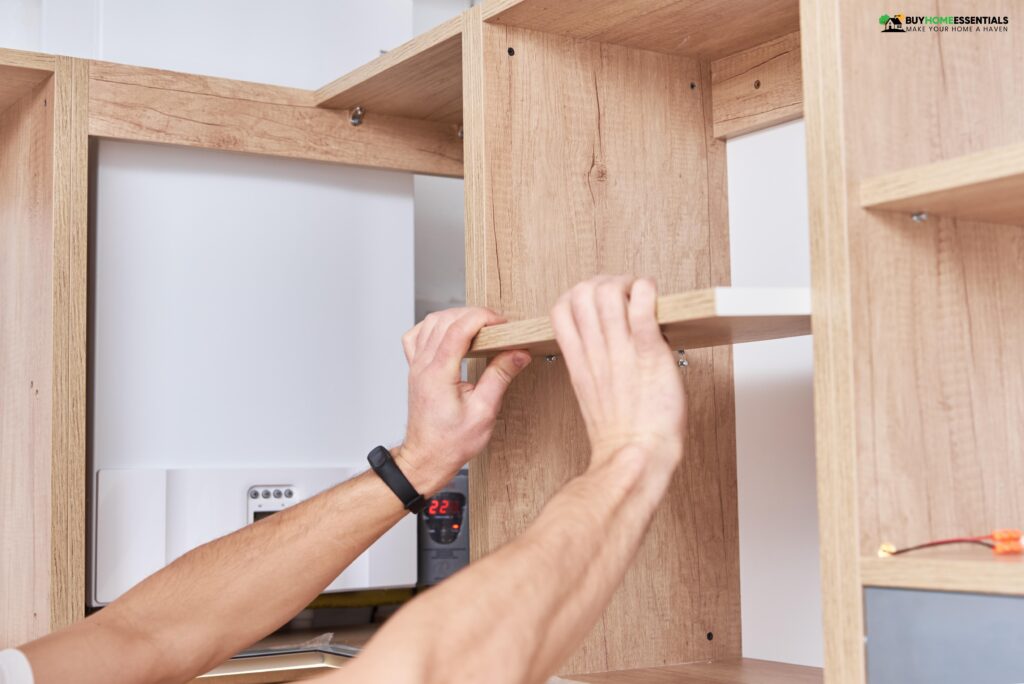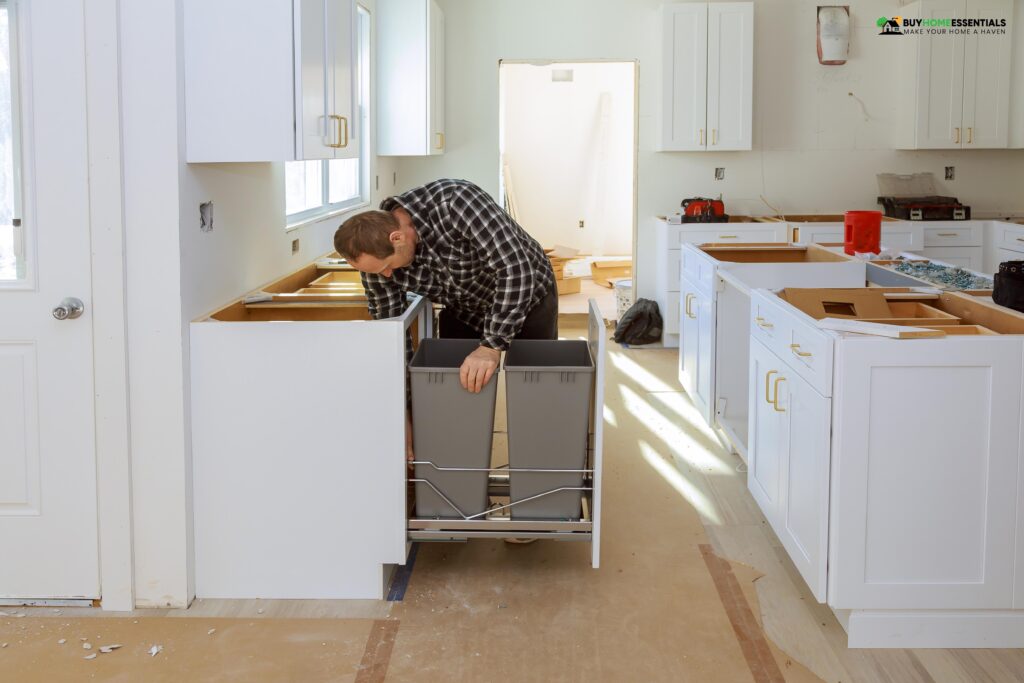Are you thinking about renovating your kitchen? Either way, understanding how to remove kitchen cabinets is crucial. Your kitchen cabinets play a crucial role in both aesthetics and functionality. They store your cookware, dishes, and other essentials while defining the style of your kitchen. However, before you install your new kitchen cabinets, you must remove the old ones.
This comprehensive guide will show you how to remove kitchen cabinets step by step. We’ve got you covered, from safely securing the right tools to removing cabinets. This guide will help you tackle this project head-on, regardless of your level of DIY experience. Let’s get started.
How to Remove Kitchen Cabinets: Steps To Follow
You should follow the following steps to remove kitchen cabinets with ease.
1. Takes Safety Precautions
It is essential to prioritize safety before removing kitchen cabinets. Keep these safety precautions in mind:
- You should always wear safety goggles, gloves, and a dust mask to protect your eyes, hands, and respiratory system.
- Some kitchen cabinets are surprisingly heavy. When dealing with larger or bulkier cabinets, ensure they’re adequately supported. You might need a sturdy ladder.
- If your cabinets have plumbing or electrical connections, turn off the water and electricity before working.
- When you remove cabinet doors and hardware, label them clearly and store them in plastic bags. As a result of this organization, reassembly will be much easier.
- Avoid overreaching or stretching to reach high areas by using the right tools. Serious injuries can result from a fall.
- Be careful not to damage the kitchen floor when moving or prying cabinets. Put drop cloths or plastic sheets on the floor.
- You should bend your knees when lifting cabinet parts and not your back. The technique reduces back strain.
2. Gather Your Tools and Materials

Gather all the tools and materials you need before removing your kitchen cabinets. Preparation will make the whole process easier and safer. Check this list to make sure you have everything:
Tools
- Screwdriver Set
- Power Drill
- Pry Bar
- Hammer
- Pliers
- Safety Gear: Gloves, Safety Goggles, and a dust mask.
Materials
- Drop Cloths or Plastic Sheets
- Painter’s Tape
- Plastic Bags and Labels
- Cardboard
- Bucket or Container
3. Organize Your Workspace
Prepare the workspace before you start removing your kitchen cabinets. It’ll make your kitchen more efficient and prevent unnecessary damage. Here’s how to set up your workspace:
- Remove all items from your countertops and the surrounding area. You’ll need to move dishes, small appliances, and anything else in your way.
- Cover the kitchen floor and countertops with drop cloths or plastic sheets. It will prevent any accidental scratches, dings, or paint spills.
- Label every cabinet door and drawer with a number or letter using painter’s tape. It’ll make reassembling them easier.
- Ensure your tools and materials are within easy reach. Keeping everything organized will save you time and frustration.
- Place fragile items and decorations away from the work area or remove them if they’re in the kitchen.
- Placing cardboard between the wall and your tools will prevent damage to your walls when prying cabinets away.
- Ensure you have a designated area for dumping trash, old cabinets, and unused materials.
4. Remove Your Cabinet Doors and Drawers
Following are the steps for removing kitchen cabinet doors and drawers.
1. Removing Cabinet Doors

Removing the cabinet doors is an essential part of kitchen cabinet removal. Here’s how to remove kitchen cabinet doors:
- Label every piece of hardware according to its location on the cabinet. For easy identification, use painter’s tape and a marker.
- Depending on the hardware, You may need a screwdriver or a power drill with an appropriate bit. Remove all screws, knobs, handles, and hinges from the doors carefully.
- Remove the cabinet doors gently after removing the hardware. You should handle them carefully to prevent damage.
- Check the cabinet doors for any damage or repairs that may be needed. Additionally, you can clean them at this time if necessary.
- Label or number the cabinet frames where the doors are attached to maintain order.
- Keep the labeled hardware and cabinet doors away from the work area in a secure, clean location.
2. Removing Cabinet Drawers

When dismantling your kitchen cabinets, starting with the drawers is often a logical first step. Here’s how to remove kitchen cabinets drawers:
- Remove all items from the cabinet drawers first. It ensures a clean workspace and prevents spills or breaks.
- The majority of drawers are equipped with glide or slide mechanisms. Follow these steps to remove them:
a. Fully extend the drawer.
b. Locate the release tabs or levers on each side of the drawer slides.
c. Depress or release these tabs while gently pulling the drawer towards you.
- As with the cabinet doors, accurately label the hardware in drawers and store it separately in bags or containers.
- Keep the drawers and their labeled hardware in a clean, secure place.
5. Remove Cabinet From Wall

You’ve prepared your workspace and removed cabinet doors and drawers, and now it’s time to remove kitchen cabinets from the wall. The following steps will show you how to remove kitchen cabinets from wall without damage:
- Assess the weight and size of any cabinets before removing them. Cabinets can be heavy and unwieldy, so knowing what you’re dealing with is crucial.
- Regarding bigger or heavier cabinets, kitchen cabinet removal is usually a two-person job. Enlist the help of a friend or family member to assist you.
- Start with removing the upper cabinets. It’s screwed to the wall most of the time, so you’ll need to remove it first.
- To prevent an upper cabinet from falling, have your assistant support its weight as you remove the final screws.
- After removing the upper cabinets, proceed to the lower ones. Often, lower cabinets are attached to each other, so remove any screws or brackets.
- Look for any additional attachments to adjacent cabinets or the wall. These can vary based on your kitchen’s design.
- Lift cabinets off the wall carefully to avoid damaging them.
- Place the cabinets away from your workspace in a safe and clean place.
6. Remove Kitchen Cabinets from Floor

Removing base cabinets is a crucial step in your kitchen renovation project. Follow these steps to remove them safely:
- Empty the base cabinets. Remove dishes, pots, pans, and any items stored in the cabinets.
- Find the screws or fasteners that hold the base cabinets to each other and the wall. It’s usually inside the cabinet or on the frame.
- Carefully detach the countertop from the base cabinets if you plan to reuse it. Some countertops require unscrewing from below or cutting through caulk or adhesive.
- When removing the last screw, have an assistant ready to support it.
- Removing base cabinets one by one can often be more manageable than removing upper cabinets. Start with the cabinet farthest from the sink or stove and work your way forward.
- Check the cabinets and surrounding area for extra attachments or brackets. Remove them as necessary.
With these steps, you can successfully remove your kitchen cabinets.
Read More: How To Organize a Pantry With Deep Shelves
FAQs
Can I remove the kitchen cabinets myself?
With the right tools and skills, you can remove kitchen cabinets yourself. Ensure you have the necessary tools like screwdrivers and drills, and take safety precautions when dealing with heavy cabinets. Plan the removal carefully, starting with the upper cabinets and labeling hardware for ease of reinstallation. After removal, assess the wall’s condition and be prepared to patch and repair it.
Think about how you’ll dispose of the old cabinets through recycling or landfill fees. Remember that cabinet removal can be physically demanding, so ensure you have the time and energy. Consult professionals for safe removal and possible reinstallation if your kitchen setup has complex plumbing or electrical connections.
How do you remove glued kitchen cabinets?
When you use the right approach, you can remove glued kitchen cabinets. Inspect the cabinets and cut through any caulk or sealant around them. After that, use wooden shims to create space between the cabinet and the wall. Take a pry bar or flat tool and gently pry the cabinet away from the wall. Don’t rush, and take your time to avoid damage.
If you have a row of cabinets, repeat the process between each one, cutting any caulk between them. After removal, clean up any adhesive residue. Consult a professional if you’re unsure or concerned about potential damage.
How much does it cost to remove base cabinets?
Several factors can affect the cost of removing kitchen cabinets. If you do it yourself, you’ll need tools and equipment like screwdrivers, drills, and safety gear. In addition, consider disposal fees, which include taking the old cabinets to a landfill or recycling facility.
Professional cabinet removal costs can vary greatly depending on the complexity of the job and your location. Professional services typically cost between a few hundred dollars and several thousand dollars. The price may include the removal and disposal of the old cabinets.
The Takeaway
If you’re remodeling your kitchen, replacing old cabinets, or just making repairs, you’ll need to know how to remove kitchen cabinets safely. You can accomplish this task effectively if you follow the precautions, tools, and techniques listed above.
Removing cabinets properly ensures a smooth transition to your next kitchen phase and minimizes home damage. Feel free to contact a professional if you have questions or encounter unexpected challenges during removal. The kitchen is a vital part of your home, so it is worth the expense to make it perfect.





